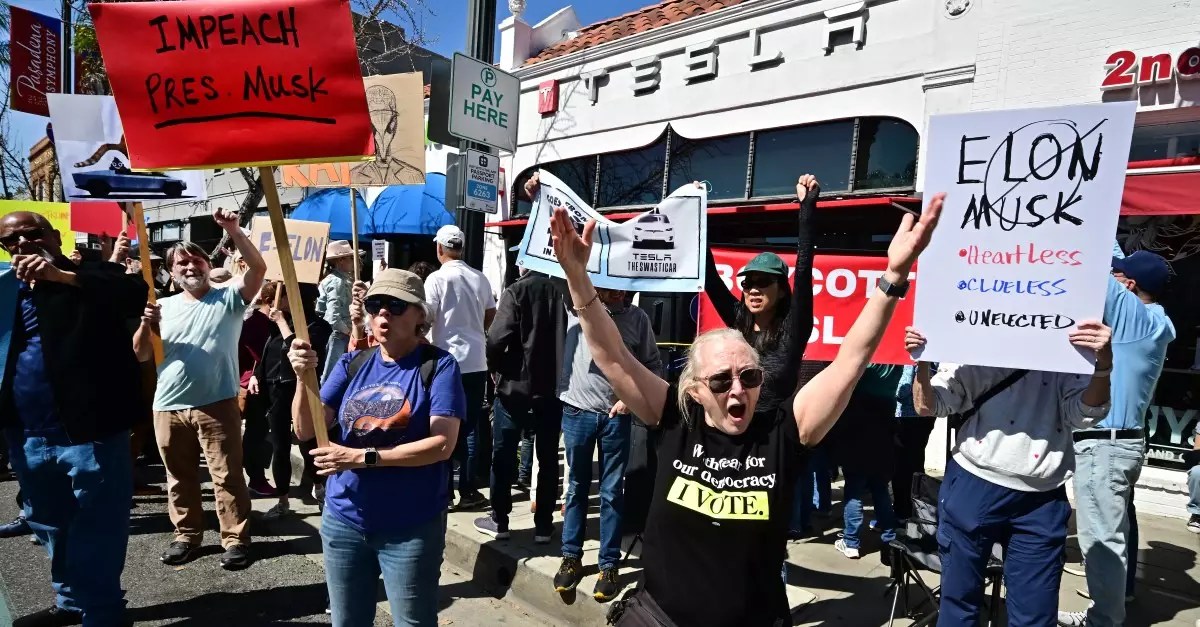On March 29th, a global wave of demonstrations is set to take place at 277 Tesla showrooms and numerous Supercharger stations around the world. This unified action, unprecedented in both scale and intent, has been organized by a coalition of citizens alarmed by the recent actions of Tesla’s CEO, Elon Musk. Initially ignited by a handful of protests that began in early February, the movement has steadily gained traction, evolving into what organizers are calling the “biggest day of action” in opposition to Musk’s leadership. With an estimated 500 protests planned, the movement clearly reflects a growing anxiety among consumers, employees, and activists regarding the direction that Musk’s decisions are taking not only Tesla but also broader economic and social frameworks.
The Catalyst for Outrage
The current dissatisfaction stems largely from Musk’s controversial policies, particularly his dismantling of federal programs that support both the economy and the workforce. As the newly-minted head of the Department of Government Efficiency (DOGE), Musk’s approach has led to the firing of tens of thousands of federal employees, igniting outrage from not just the general public but also influential voices in Congress and popular culture. Protesters, branding themselves as “Tesla Takedown,” view these drastic changes not merely as corporate maneuvers but as actions that undermine the rights and well-being of citizens. As one protest organizer astutely stated, “We are fighting for our country, our democracy, and our freedoms,” emphasizing that the movement represents a collective stand against perceived authoritarian practices.
Challenges and Risks
The protesters are asserting their rights through nonviolent means, yet they are also acutely aware of the risks involved. The calls for government scrutiny and threats of domestic terrorism charges by figures like Attorney General Pam Bondi signal a chilling climate for dissent. Legal experts are advising demonstrators to be well-versed in the laws governing protests in their respective states, lest they become targets of intimidation tactics designed to suppress activism. This dynamic points to a larger trend: as public dissent grows, so too does the pushback from authorities intent on maintaining order.
The Economic Implications of Activism
The declining stock prices of Tesla, which have plummeted nearly 40% this year, have further energized this movement. As many proponents argue, weakening Tesla’s market hold is strategically sound. Speakers at community mobilization calls have articulated a vision wherein harming Tesla’s financial footing will prompt substantial changes within the company. Influential voices within the protests argue that the drop in stock value can trigger a spiral detrimental not only to Musk’s wealth but also to the company’s operational framework. As investigative journalist Micah Lee pointed out, disrupting Tesla’s financial trajectory might serve as a lever to force Musk to address the concerns of both employees and consumers, particularly in light of his vast expenditures on other ventures like Twitter.
The Complicated Relationship Between Musk and Power
Musk’s entrenchment within the corridors of power complicates the effectiveness of these protests. Having consolidated a remarkable amount of political clout, illustrated by his close ties with the Trump administration, many wonder how much sway public sentiment can truly wield over him. Critics argue that no matter the outcome of these demonstrations, Musk’s ability to navigate both corporate and political landscapes allows him to sidestep some of the consequences borne from dwindling public opinion and stock value.
Moreover, Musk’s unconventional personality and penchant for online engagement—often expressed through memes and social media banter—further detach him from the realities faced by average citizens. This dual existence, straddling the realms of wealth, power, and popular culture, challenges the effectiveness of traditional protest strategies. The world’s richest man, who sees himself as rebellious and subversive, may not perceive grassroots movements as threats as much as mere nuisances to be navigated.
Future Directions for Activism
As the scale of these planned protests reveals, there’s both passion and urgency behind the calls for action—demonstrating that a growing portion of society is unwilling to remain complacent. The call for 500 demonstrations is not merely a number; it represents a collective plea for accountability and transparency from corporate leaders who have, in many instances, garnered power beyond their responsibilities. Each rally is a beacon signaling discontent and invoking a wider dialogue about corporate governance, federal accountability, and the potential for public mobilization to instigate change.
Going forward, the challenge for activists will be to maintain this momentum, ensuring that the conversations initiated in the streets will influence policy discussions in the halls of power. As societal awareness rises, so too does the need for strategic and peaceful protests that can resonate with a broader audience—navigating the complexities of public opinion, corporate responsibility, and government oversight. The March 29th demonstrations may just be the start of a recalibration in the ongoing conversation surrounding corporate ethics and their intersection with political authority.


Leave a Reply